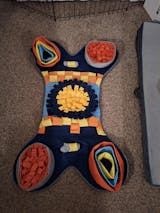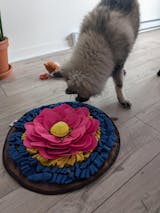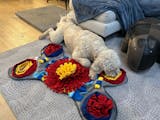Enrichment is crucial for dogs' mental and physical health. Engaging dogs in activities that stimulate their minds and bodies helps prevent boredom, reduces stress, and curbs unwanted behaviors. In our fast-paced world, many dogs spend hours alone at home, which can lead to restlessness and anxiety. To counter this, providing varied enrichment activities is essential.
There are five main types of enrichment for dogs:

Each type addresses a different aspect of your dog’s well-being, working together to improve their behavior and overall quality of life.
1. Social Enrichment: The Importance of Interaction
Social enrichment provides your dog with opportunities to interact with other dogs, people, and different environments. Well-socialized dogs tend to be more confident and less anxious, making them more adaptable to changes and new experiences.

Examples of social enrichment activities include:
- Supervised playdates with other dogs
- Walks in dog-friendly parks or neighborhoods
- Visits to pet stores or cafes
- Participating in group dog classes
These activities expose your dog to various stimuli, helping them build social skills and reducing the likelihood of fear or aggression in unfamiliar situations.
2. Nutritional Enrichment: Feeding the Mind Through Food
Nutritional enrichment taps into a dog’s instincts to forage and work for food, making mealtime both mentally stimulating and rewarding. This is where tools like dog enrichment mat come into play. A snuffle mat allows dogs to use their sense of smell to "hunt" for kibble or treats hidden within the fabric, turning a regular feeding session into an engaging challenge.

Other methods of nutritional enrichment include:
- Puzzle feeders
- Hiding treats around the house
- Offering meals in slow feeders to encourage thoughtful eating
- Scattering kibble around the yard for your dog to find
These activities not only make feeding time more enjoyable but also slow down fast eaters, reducing the risk of bloating or digestive issues.
3. Occupational Enrichment: Giving Your Dog a Purpose
Dogs, especially those from working breeds, need mental challenges to keep them engaged. Occupational enrichment gives dogs a "job" to do, helping them focus their energy and avoid boredom-related behaviors like excessive barking or chewing. For instance, some dogs thrive on agility courses that challenge their physical and cognitive abilities.

Occupational enrichment ideas include:
- Agility training or obstacle courses
- Fetch or retrieving games
- Puzzle dog toy that make them work for food
- Teaching new commands or tricks
For herding breeds or other high-energy dogs, giving them tasks or games that require problem-solving can provide a much-needed outlet for their instincts.
4. Sensory Enrichment: Engaging the Senses
Dogs rely heavily on their senses, especially smell. Sensory enrichment focuses on stimulating your dog’s sight, sound, smell, and even taste to keep them mentally engaged and reduce anxiety. Nosework games, for instance, allow dogs to use their powerful sense of smell to search for hidden treats, a task that comes naturally to them.
Examples of sensory enrichment include:
- Nosework games where dogs hunt for treats based on scent
- Playing calming music or nature sounds
- Using scented toys or blankets
- Offering different textured chew toys
Stimulating their senses can be particularly beneficial for dogs who are nervous or stressed, as it provides a natural way for them to focus and relax.
5. Physical Enrichment: Keeping Dogs Active
Physical enrichment involves exercise and play, which are essential for a dog’s physical health and energy management. A well-exercised dog is less likely to engage in destructive behaviors, as their need for movement and stimulation has been met.

Some physical enrichment ideas are:
- Daily walks in new environments
- Playing fetch or tug-of-war
- Running or jogging with your dog
- Interactive toys that promote chasing or jumping
Combining physical and mental activities, such as agility training or using puzzle feeders that require movement, offers the best of both worlds, ensuring your dog stays active and engaged.
Bringing It All Together: A Balanced Approach to Enrichment
To ensure your dog is happy and healthy, it’s essential to incorporate a variety of enrichment activities that address their mental, physical, and emotional needs. By combining social, nutritional, occupational, sensory, and physical enrichment, you can provide a well-rounded approach to keeping your dog stimulated and satisfied.
For instance, using a PawzNDogz snuffle mat for dogs during mealtime offers both nutritional and sensory enrichment, while playing fetch or teaching your dog new tricks combines physical and mental challenges. Balancing these different types of enrichment helps create a richer, more fulfilling life for your dog, leading to better behavior and a stronger bond between you and your furry friend.
Enrichment for dogs isn’t just a luxury—it’s a necessity for their overall well-being. By understanding and incorporating these types of activities into your dog's routine, you help ensure that they are mentally sharp, physically fit, and emotionally balanced, contributing to a happier and healthier life.







